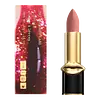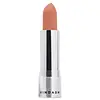What's inside
What's inside
 Key Ingredients
Key Ingredients

 Benefits
Benefits

 Concerns
Concerns

 Ingredients Side-by-side
Ingredients Side-by-side

Isononyl Isononanoate
EmollientAluminum Starch Octenylsuccinate
AbsorbentMica
Cosmetic ColorantPolybutene
Polyethylene
AbrasiveDicalcium Phosphate
AbrasiveParaffin
PerfumingBis-Diglyceryl Polyacyladipate-2
EmollientEuphorbia Cerifera Wax
Caprylic/Capric Triglyceride
MaskingMicrocrystalline Wax
Emulsion StabilisingCopernicia Cerifera Wax
Kaolin
AbrasiveNylon-12
Pentaerythrityl Tetra-Di-T-Butyl Hydroxyhydrocinnamate
AntioxidantPolyhydroxystearic Acid
EmulsifyingPropylene Carbonate
SolventSqualane
EmollientStearalkonium Hectorite
Gel FormingSynthetic Wax
AbrasiveCI 77891
Cosmetic ColorantIron Oxides
CI 15850
Cosmetic ColorantCI 45410
Cosmetic ColorantCI 15985
Cosmetic ColorantCI 42090
Cosmetic ColorantCI 19140
Cosmetic ColorantIsononyl Isononanoate, Aluminum Starch Octenylsuccinate, Mica, Polybutene, Polyethylene, Dicalcium Phosphate, Paraffin, Bis-Diglyceryl Polyacyladipate-2, Euphorbia Cerifera Wax, Caprylic/Capric Triglyceride, Microcrystalline Wax, Copernicia Cerifera Wax, Kaolin, Nylon-12, Pentaerythrityl Tetra-Di-T-Butyl Hydroxyhydrocinnamate, Polyhydroxystearic Acid, Propylene Carbonate, Squalane, Stearalkonium Hectorite, Synthetic Wax, CI 77891, Iron Oxides, CI 15850, CI 45410, CI 15985, CI 42090, CI 19140
Octyldodecanol
EmollientPolysilicone-11
Synthetic Wax
AbrasiveSilica
AbrasiveCaprylic/Capric Triglyceride
MaskingKaolin
AbrasiveCopernicia Cerifera Wax
Stearalkonium Bentonite
Gel FormingSynthetic Beeswax
Emulsion StabilisingSodium Potassium Aluminum Silicate
Lauroyl Lysine
Skin ConditioningPropylene Carbonate
SolventAroma
Dicalcium Phosphate
AbrasivePolyhydroxystearic Acid
EmulsifyingLaureth-12
EmulsifyingPentaerythrityl Tetra-Di-T-Butyl Hydroxyhydrocinnamate
AntioxidantTitanium Dioxide
Cosmetic ColorantCI 77891
Cosmetic ColorantIron Oxides
CI 77491
Cosmetic ColorantCI 19140
Cosmetic ColorantCI 15985
Cosmetic ColorantBlue 1 Lake
Cosmetic ColorantCI 42090
Cosmetic ColorantCI 15850
Cosmetic ColorantOctyldodecanol, Polysilicone-11, Synthetic Wax, Silica, Caprylic/Capric Triglyceride, Kaolin, Copernicia Cerifera Wax, Stearalkonium Bentonite, Synthetic Beeswax, Sodium Potassium Aluminum Silicate, Lauroyl Lysine, Propylene Carbonate, Aroma, Dicalcium Phosphate, Polyhydroxystearic Acid, Laureth-12, Pentaerythrityl Tetra-Di-T-Butyl Hydroxyhydrocinnamate, Titanium Dioxide, CI 77891, Iron Oxides, CI 77491, CI 19140, CI 15985, Blue 1 Lake, CI 42090, CI 15850
Ingredients Explained
These ingredients are found in both products.
Ingredients higher up in an ingredient list are typically present in a larger amount.
This ingredient is an emollient, solvent, and texture enhancer. It is considered a skin-softener by helping the skin prevent moisture loss.
It helps thicken a product's formula and makes it easier to spread by dissolving clumping compounds.
Caprylic Triglyceride is made by combining glycerin with coconut oil, forming a clear liquid.
While there is an assumption Caprylic Triglyceride can clog pores due to it being derived from coconut oil, there is no research supporting this.
Learn more about Caprylic/Capric TriglycerideCi 15850 is the pigment color red. It is an azo dye and created synthetically.
Azo dyes need to be thoroughly purified before use. This allows them to be more stable and longer-lasting.
This ingredient is common in foundations, lipsticks, and blushes. This color is described as brown/orangey red.
It has many secondary names such as Red 6 and Red 7. According to a manufacturer, Red 6 usually contains aluminum.
Learn more about CI 15850Ci 15985 is a dye made from petroleum. It is synthetically created and approved by the FDA for use in foods and cosmetics.
The color of this dye is orange/yellow.
This ingredient can be found in makeup, sun care, and skincare.
Learn more about CI 15985CI 19140 is also known as Tartrazine. Tartrazine is a synthetic dye used in cosmetics, foods, and medicine to add a yellow color.
Tartrazine is created from petroleum and is water-soluble.
Some people may experience allergies from this dye, especially asthmatics and those with an aspirin intolerance.
Learn more about CI 19140Ci 42090 is a synthetic dye created from petroleum. It is used to give a bright blue color to cosmetics, medicine, and food.
Ci 77891 is a white pigment from Titanium dioxide. It is naturally found in minerals such as rutile and ilmenite.
It's main function is to add a white color to cosmetics. It can also be mixed with other colors to create different shades.
Ci 77891 is commonly found in sunscreens due to its ability to block UV rays.
Learn more about CI 77891Copernicia Cerifera Wax comes from a palm tree native to Brazil; another name for this ingredient is Carnauba Wax.
This ingredient is used to thicken texture and also leaves behind a film when applied.
Fun fact: This wax has the highest melting point of all natural waxes and low solubility.
Learn more about Copernicia Cerifera WaxDicalcium Phosphate is an exfoliant.
Kaolin is a clay. It is used for oil control and to help minimize pores. Like other clays, kaolin has the ability to absorb excess sebum or oil. This can help clean out pores and mattify the skin.
Some types of kaolin may have exfoliating properties. When water is added to kaolin, it becomes a paste with small abrasive particles.
Most kaolin is a white color, but may be pink/orange/red depending on where it comes from.
The name 'kaolin' comes from a Chinese village named 'Gaoling'. Kaolin clay comes from rocks rich in kaolinite. Kaolinite, the mineral, has a silicate layered structure. Kaolinite is formed from chemical weathering of aluminum siilicate minerals.
Besides skincare, kaolin is commonly used to make glossy paper, in ceramics, toothpaste, and as medicine to soothe stomach issues.
Learn more about KaolinPentaerythrityl Tetra-Di-T-Butyl Hydroxyhydrocinnamate (long name, huh?) is a synthetic antioxidant.
It is used to help stabilize other antioxidants or prevent the color from changing in a product.
As an antioxidant, it helps fight free-radical molecules. Free-radical molecules are capable of damaging our cells and other genetic material. Thus, antioxidants may reduce the signs of aging.
This ingredient is oil-soluble.
Learn more about Pentaerythrityl Tetra-Di-T-Butyl HydroxyhydrocinnamatePolyhydroxystearic Acid is a soft wax made from castor oil.
It is is a texture thickener, emulsifier, and film-former. Emulsifiers prevent ingredients from separating, such as oils and waters.
Polyhydroxystearic Acid may not be fungal acne safe.
Learn more about Polyhydroxystearic AcidThis ingredient is a solvent. It helps dissolve active ingredients and alter the texture of products.
Propylene Carbonate is commonly used in makeup and with clay, such as montmorillonite or bentonite.
Studies show this ingredient to be safe for cosmetics. When it is undiluted, it can cause skin irritation. (It is always diluted in skincare and makeup). This ingredient is water-soluble.
Propylene Carbonate is created from propylene glycol and carbonic acid.
Learn more about Propylene CarbonateSynthetic Wax is created from fossil fuels such as natural gas. It is used to enhance texture, adjust pH, and as an occlusive.
It may also be used as an abrasive ingredient to exfoliate the skin.
Synthetic Wax may not be fungal acne safe.
Learn more about Synthetic WaxThis ingredient is a combination of red, black, and yellow iron oxide pigments. This combination of colors is usually found in foundation, because it results in a "skin" color.